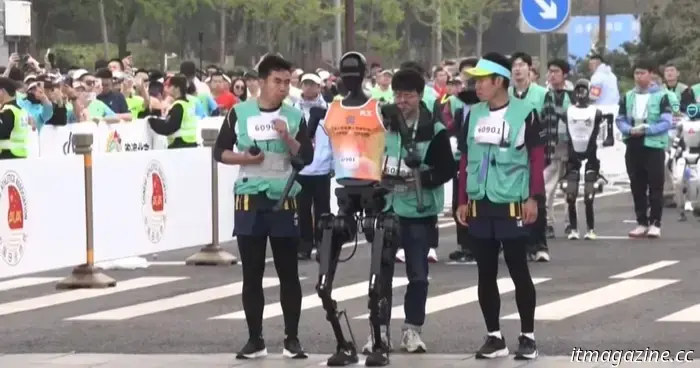
Humanoid robots compete alongside humans in a distinctive half-marathon event in China.
You may have witnessed robots imitating the dance moves of music legend Mick Jagger, performing parkour, or even creating artwork. The arrival of Tesla’s Optimus humanoid robot has generated significant excitement, while Google and Meta are also gearing up to explore this domain. However, the competition in the East is on a whole different scale.
China has recently tested humanoid robots in the world’s first race of its kind, where they raced alongside humans in a half-marathon. In total, 21 robots participated in the Yizhuang half-marathon after undergoing extensive supervised learning on outdoor surfaces.
The event featured a variety of robotics companies displaying their creations. Some robots stood at a height of just 3.9 feet, while others reached a standard human height of 5.9 feet. Some robots stumbled, a few managed to get back on their feet unaided, while a handful required assistance from humans.
Throughout the race, the humanoid robots navigated challenging terrains, including steep inclines, potholes, puddles, and smooth asphalt. Although battery changes were permitted, doing so would result in a significant penalty. Despite interventions from robotics and software experts, not all robots were able to complete the race.
Did the robots outperform the humans?
Not really, and the difference in performance was substantial. The human winner completed the half-marathon in just over one hour, while the best-performing humanoid robot finished in 2 hours and 40 minutes.
This results in an average speed of 4.89 miles per hour. For perspective, Olympic champion Usain Bolt clocked a peak speed of 27.33 miles per hour during a track event in 2011. However, the objective was never to surpass human runners, even though the robot's performance exceeded the engineering team's expectations by about half an hour.
The half-marathon in China served more as a display of the advancements made by local robotics companies. The winning humanoid robot, called Tiangong Ultra, was developed by the Beijing Innovation Center of Human Robotics.
A significant achievement
“I don’t mean to brag, but I believe no other robotics firms in the West have reached the same level of sporting success as Tiangong,” Tang Jian, the head of the company behind the winning robot, was quoted by Reuters.
This is a state-backed enterprise in which Chinese electronics giant Xiaomi is a major investor. According to the South China Morning Post, the goal of the company is to become “the Android in the humanoid robot sector.” For the half-marathon, some modifications were made to enhance performance.
“We reduced the robot's weight without sacrificing strength, optimized its leg design, and enhanced its thermal conductivity and air-cooling systems to improve stability and endurance,” Guo Yijie, a technician for the Tien Kung Ultra robot, stated to Xinhua.
Participating firms and the organizers of the unique half-marathon emphasized that the primary aim is to demonstrate the integration of humanoid robots into human environments. These robots will soon transition from design labs to industrial applications, with the ultimate vision of integrating them into the average household as helpful assistants.





Other articles
.jpg) Preorder the Light Phone III and get a $200 discount (as well as peace of mind).
You can now pre-order the Light Phone III with a discount of $200. Interested in a phone designed for digital detox? Grab it for just $599 while this offer is available.
Preorder the Light Phone III and get a $200 discount (as well as peace of mind).
You can now pre-order the Light Phone III with a discount of $200. Interested in a phone designed for digital detox? Grab it for just $599 while this offer is available.
 Hayden Christensen is set to reprise his role in season 2 of Ahsoka.
At Star Wars Celebration, Rosario Dawson announced that Hayden Christensen will return for season 2 of Ahsoka.
Hayden Christensen is set to reprise his role in season 2 of Ahsoka.
At Star Wars Celebration, Rosario Dawson announced that Hayden Christensen will return for season 2 of Ahsoka.
 Delroy Lindo states that Marvel's Blade film 'lost its direction.'
The film has been completely taken off Marvel's release calendar and appears to be in a state of creative uncertainty.
Delroy Lindo states that Marvel's Blade film 'lost its direction.'
The film has been completely taken off Marvel's release calendar and appears to be in a state of creative uncertainty.
 The top A24 films highlight the reasons the indie company has built a fanbase in recent years, with standout titles like Lady Bird and Moonlight.
The top A24 films highlight the reasons the indie company has built a fanbase in recent years, with standout titles like Lady Bird and Moonlight.
 It’s starting to seem as though gaming may not be for everyone.
The cost of the Nintendo Switch 2 raises concerns about who might be excluded as gaming equipment becomes more expensive.
It’s starting to seem as though gaming may not be for everyone.
The cost of the Nintendo Switch 2 raises concerns about who might be excluded as gaming equipment becomes more expensive.
 Amazon announces a new date for the launch of its Project Kuiper.
Amazon's first attempt to launch its Project Kuiper internet satellites on April 9 did not go as planned due to unfavorable weather conditions, which led the mission team to delay the launch. Until Thursday, there had been no updates from Amazon or United Launch Alliance (ULA), the operator of the Atlas V rocket that was scheduled to carry the satellites.
Amazon announces a new date for the launch of its Project Kuiper.
Amazon's first attempt to launch its Project Kuiper internet satellites on April 9 did not go as planned due to unfavorable weather conditions, which led the mission team to delay the launch. Until Thursday, there had been no updates from Amazon or United Launch Alliance (ULA), the operator of the Atlas V rocket that was scheduled to carry the satellites.
Humanoid robots compete alongside humans in a distinctive half-marathon event in China.
In the capital city of China, more than a dozen humanoid robots of various sizes stood in formation for a pioneering half-marathon event alongside human participants.
